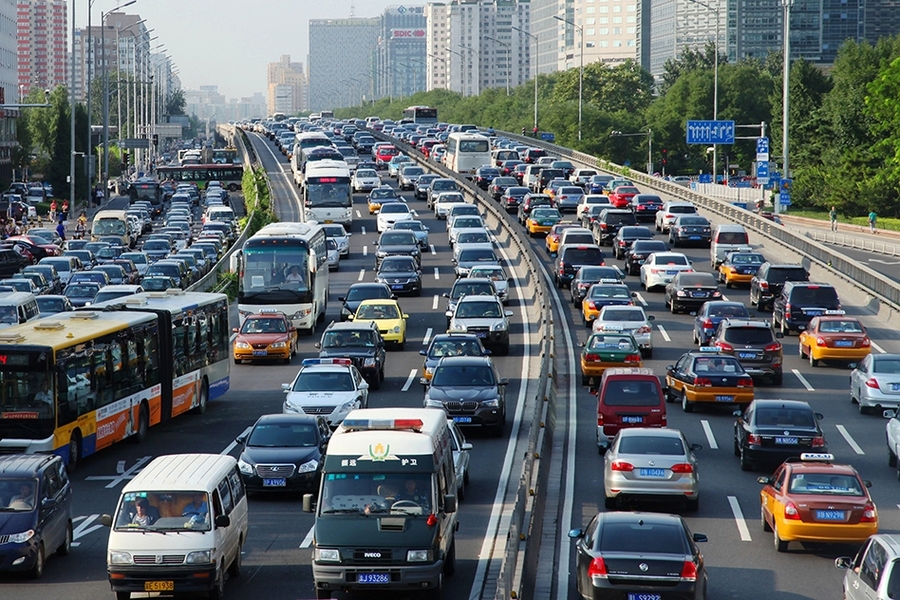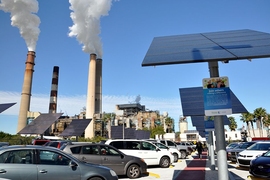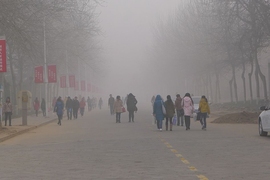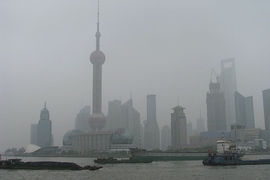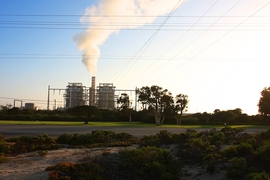A recent study estimates that about 1.6 million people in China die each year — roughly 4,000 a day — from heart, lung, and stroke disorders due to poor air quality. Most of the nation’s lethal air pollution, including headline-grabbing toxins such as fine particulate matter (PM2.5) and ground-level ozone (O3), is produced in its coal-dominated energy and industrial sectors. But a substantial and growing contributor to the problem is road transportation; as private vehicle ownership and freight traffic increase, so, too, do ambient concentrations of pollutants from gasoline and diesel fuel exhaust.
Concerned about ongoing health risks linked to high concentrations of air pollutants, China has recently taken measures that are expected to improve its air quality. These include an economy-wide climate policy that puts a price on carbon dioxide (CO2) and lowers emissions that degrade air quality, and tailpipe and fuel-economy standards that target vehicle emissions only. What remains to be seen is how effective these measures will be in reducing China’s air pollution problem.
Addressing that question head-on, a new study in the journal Transportation Research Part D: Transport and Environment evaluates the combined impact on China’s air pollution levels of implementing both an economy-wide climate policy and vehicle emissions standards. Using an energy-economic model, a team of researchers from MIT, Tsinghua University, and Emory University finds that by 2030, these policies will act on different sectors in a coordinated fashion to address both climate change and air pollution. Implementation of China’s current vehicle emissions standards — or more stringent versions thereof — will considerably reduce road transportation’s contribution to the nation’s total air pollution, while an economy-wide price on CO2 will significantly lower air pollution from other sectors of the economy through incentivizing a transition to less carbon-intensive energy sources such as natural gas and renewables.
“In any province, transportation produces at most a quarter of all emissions that cause air pollution in China,” says Paul Natsuo Kishimoto, the paper’s lead author, a PhD candidate at the MIT Institute for Data, Systems and Society, and research assistant at the MIT Joint Program on the Science and Policy of Global Change. “Improving fuel economy and emissions control technology on new vehicles and replacing old cars, trucks, and buses would sharply reduce the transportation sector’s share of the problem — but have no effect on the rest of the country’s air pollution emissions. On the other hand, a climate policy would impact not only that transport share but everything else. An economy-wide carbon price would help reduce carbon emissions throughout the country, but especially in non-transportation sectors where it’s far less expensive to cut emissions. Both approaches are necessary and complimentary.”
To examine the impact on China’s air pollution of combining these approaches — and the relative contributions of each to alleviating the problem — the researchers used models to project future economic activity, including transportation, and energy use associated with that activity, and calculated total emissions of health-compromising pollutants from transportation and other energy users. Using the China Regional Energy Model (C-REM), a computable general equilibrium model developed by the China Energy and Climate Project (CECP), along with a “fleet model” that distinguishes road vehicles by model year (an indicator of tailpipe and fuel economy performance), they simulated the interaction of road-transportation emissions standards and an economy-wide CO2 price between the years 2010 and 2030.
To provide the sharpest estimates of how these policies would impact emissions across China, the simulations were implemented at the provincial level.
“Pollutants emitted in densely populated eastern provinces, or under different atmospheric conditions, will have different effects on air quality,” Kishimoto explains. “By modelling at the provincial level, we preserve these differences instead of rolling them into an unrepresentative national average.”
With an average annual increase of 7.5 percent in transportation energy demand over the simulation period, the researchers ran different scenarios representing various levels of stringency for vehicle emissions standards and climate policy, and found that existing emissions standards would reduce road transport emissions by more than 99 percent, but total emissions by roughly 15 percent or less, depending on the province. They also determined that more stringent emissions standards under consideration by the Chinese government would do little to achieve further reductions in total emissions. At the same time, they found that a more stringent climate policy could reduce up to 48 percent of total emissions by affecting the energy and industrial sectors, but make only a small dent in emissions from road transport.
Combining the two approaches would thus be a viable strategy to reduce air pollution from both transportation and non-transportation sources. Toward that end, the researchers recommend that China develop more robust mechanisms to enforce recently enacted vehicle emissions standards, and continue efforts aimed at setting a national price on carbon dioxide that covers most, if not all, sectors.
“It is very important that policymakers are aware of the interactions between air quality policies and climate change policies,” says Valerie Karplus, a co-author of the study who is an assistant professor of global economics and management at the MIT Sloan School of Management and director of the China Energy and Climate Project. “This information enables decision-makers to choose policies that reap co-benefits by reducing non-target pollutants — and do not work at cross purposes.”
Focused on energy and climate change governance in China, the CECP is an ongoing project that combines expertise from the MIT Joint Program and the Institute for Energy, Environment and Economy at Tsinghua University.
